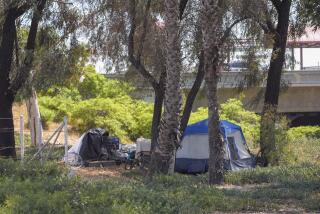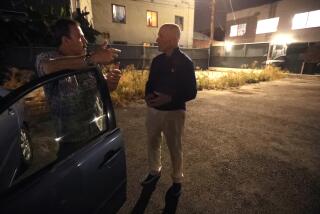How to unharden our hearts toward homeless people

- Share via
It’s funny how off first impressions can be. I’ve driven through the underpass below the 101 Freeway at Laurel Canyon Boulevard and seen what looked to me like trash and what looked to me like junk. I’ve seen homeless people who appeared, to my driver-cruising-by eyes, to be lying listless or maybe passed out.
The view was different when I went there on foot one day this week, to visit a friend I’d recently made and introduced to all of you.
Patti had been holding an “Every little bit helps” sign on the northbound freeway off-ramp. I’d watched Mercedes and Porsche drivers look through her.
I’d asked her what she could use that would bring her immediate comfort while she waits for housing. She’d mentioned a soft blanket, a Subway gift card, a TAP card loaded with enough bus fare to get her to a place in Burbank that she told me offers kindness and hot showers.
The sun had just set when I brought her the cards and the softest blanket I could find, the same faux-fur number I curl up under when watching TV at home. It was getting dark. I didn’t see her, until her neighbor pointed to a clump of bedding with a black umbrella open on top of it. Patti was under that umbrella, safer for being invisible, trying to relax with a slight sound buffer as car after car rumbled by.
Someone had given her a two-month subscription to Netflix. Earbuds in, she was watching a fantasy series on her cellphone, which was being charged on a power bank. What might have looked like detritus to me as a passing driver was her try at indoor coziness outdoors: plump pillows, stuffed animals, her feet snuggled up in her sleeping bag.
I share this about Patti, who turned 68 a few days ago and whose rheumatoid arthritis was making her hands hurt a lot that evening, because I’ve made the pitch that we all should try to find some way to help some of the thousands of unhoused people living among us.
Yes, of course, they need housing and jobs, and many need treatment for addiction or mental illness.
This week, hundreds of people all over the area spread out night after night to attempt to visually count our homeless population, which is key for funding and for trying to comprehend the scope of the problem and for figuring out how to allocate resources well.
But that’s on an institutional level. I’m talking about a different kind of aid, one to one, person to person. I would argue that many homeless people also desperately need basic human kindness, which we can offer as individuals while we work as a society to try to get them that much bigger aid.
To me, that starts with making respectful contact, one human being born naked and wailing to another born the same way. Contact can mean a lot more than you might think to isolated, ostracized people who are used to being ignored.
Patti teared up at the sight of the plush blanket, which she kept rubbing against her cheek. She teared up at the cards and because I had asked what could help her, and listened. But mostly, she teared up at the sight of me returning, which experience had taught her not to count on.
“You know this is such a surprise,” this former New Yorker told me in an accent and cadence that reminded me of my maternal grandmother’s. “It really is, because ordinarily people just come around the one time.”
Then she made some space for me to settle in beside her and opened up to me more about her life. Her hands hurt her but she kept holding my hands as we talked.
I defy anyone who goes out and meets someone like Patti on a sidewalk to continue to see only an amorphous, scary blob labeled “homelessness” and not start to distinguish in it at least some individuals whom they deem deserving of their kindness and conversation and aid.
That was one big point I was making when I brought this up before. A few people thought I was lecturing them, which was never my intent. But I heard from many more readers who felt differently. A lot of them told me that they hadn’t known how to help and appreciated the practical advice. Some said that they’d gone out right away to get items such as socks, wet wipes and cold medicine that the homeless people I had talked to said they would find helpful.
Catherine Keefe of Trabuco Canyon wrote to tell me that she’d thought about my column and about Patti when she was shopping at Pavilions and so bought a $25 Subway gift card to give to the man she’d often seen outside, holding a sign that identified him as a homeless veteran, looking for work. She had to overcome her painful shyness, she wrote.
“I loaded my groceries into the trunk, put the gift card in my hand, then decided to fill in the empty lines.
TO: You
FROM: The world
MESSAGE: I see you”
Evan Lovett of Studio City wrote to say that the encounters I’d described with people I’d met on the streets had been “tonic” for his “calcifying heart.”
He said he was the “son of liberal parents who would learn the names of our neighborhood homeless, bring them food and provide money. I learned that these people were ‘down on their luck’ or just ‘needed help/positivity.’”
But after college, he wrote, he wouldn’t go out of his way to help the homeless though he would give money “on off-ramps or outside 7-11, etc.”
Then, when he became a parent, it was as if “a switch flipped,” he wrote. He became one of the people who immediately contacted the city and his councilman “or literally asked the people to leave the neighborhood when they’d form encampments.”
“There was a point where I was cursing my vote for HHH,” he wrote of the $1.2 billion bond we L.A. voters passed for homeless housing, “... as I stopped believing any of these people even wanted improvement in their lives.”
My column, he said, shifted something within him and “just brought back the soul to these people (in my eyes) and provided a real understanding to the plight, as well as some ‘what can I do to not feel like I’m facilitating this problem’ action items. Just wanted to say thank you for ... bringing me back to a perspective my mom could have been proud of.”
If that had been the only note I’d gotten, I wrote back to him, that would have been more than enough for me.
I just want people to think, empathy forward, and make an attempt to engage before writing off a vast population and ranting that it needs to be removed.
When Catherine Keefe handed the Subway gift card to the homeless man outside the supermarket in Rancho Santa Margarita, by the way, he offered her a card whose words might have the power to crack even a very hardened heart.
“Troy the Painter, 48 years Experience,” it read, “Specializing in Weatherizing.”
In my experience, when you really talk to a homeless person, when you ask questions and listen, you’re likely to learn a lot that you may not fully understand about what it is to be homeless. It is a deeply alienating existence. You can’t just assume that you know.
To that end, I’m very interested in a proposal pushed by L.A. Councilman Mike Bonin to create a city commission made up of homeless and formerly homeless people who could give public voice to their thoughts about the many efforts to solve the homeless crisis with the authority of their lived experience. It’s been tried to various degrees elsewhere. It’s something I want to learn more about.
I went to talk to Bonin about it this week, and we discussed some of the issues that homeless people often have with a lot of the care potentially available to them — the requirements for IDs they don’t possess, for instance, or the shelter rules that require them to separate from their partners and their pets and the few belongings they have managed to hold on to.
Patti told me that when someone tried to get her into a shelter in the Valley, she was crying within a few moments of getting there. There were too many people. Some were screaming. It was all far too much for her. She had to get out.
These are the sorts of issues we need to learn to hear better, Bonin told me.
“If nothing else, from a customer-service perspective, if we are trying to provide a service to get people off the street and that service isn’t working,” he said, “among the people we should be consulting are the people we are trying to serve.”
He understands life’s precariousness particularly well. He once nearly was on the streets himself. Alcohol and crystal meth were destroying his life. On Feb. 4, he will celebrate 25 years of sobriety, whose onset he marked, he told me, by getting a tattoo of the symbol for recycling. It was a metaphor, he said, for the change he was making in his life, “taking something that was crashed and wasted and trying to make it reusable.”
“We’re all fragile. We are all broken. And we all fall down. And we often need help getting up,” he told me.
Talking to homeless people and listening to them and hearing what they think might work for them seems to me to be one good way to start.
More to Read
Sign up for Essential California
The most important California stories and recommendations in your inbox every morning.
You may occasionally receive promotional content from the Los Angeles Times.











